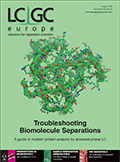Advantages of Supported Liquid Extraction
In this excerpt from LCGC Europe’s e-learning platform, CHROMacademy.com, the advantages of supported liquid extraction (SLE) are discussed.
In this excerpt from LCGC Europe’s e-learning platform, CHROMacademy.com, the advantages of supported liquid extraction (SLE) are discussed.
Although traditional liquid–liquid extraction (LLE) is very widely used, it has a number of fundamental disadvantages. Large amounts of solvents may be consumed; flask shaking can be highly labour intensive and somewhat subjective, and the glassware used needs to be thoroughly cleaned. There is a risk of emulsion formation that can be difficult to deal with. The process is typically run in serial, as opposed to in parallel, which limits throughput, and the traditional shakeâflask methods are not amenable to automation.
Supported liquid extraction (SLE) is an analogue of the traditional LLE approach, which uses the same extraction principle of partitioning of target analytes between two immiscible phases, but in the SLE technique the aqueous phase is coated onto a high surface area material (typically diatomaceous earth) held within tubes, cartridges, or plates similar to those used in solid-phase extraction (SPE). The extraction solvent is passed through the cartridge, and a very highly efficient extraction occurs via partitioning of the target analytes between the immobilized aqueous and slowly moving organic phases.
In the first stage of the SLE process, the aqueous sample is introduced into the high-surface-area sorbent and is allowed to penetrate the material through capillary action and surface adsorption, typically over a period of 5–10 min.
It is possible, as with conventional LLE methods, to adjust the pH of the aqueous sample or its ionic strength to promote the efficient partitioning of the analyte into the organic phase. Indeed, some SLE materials are available in prebuffered form, which will adjust the aqueous sample pH as it is added to the sorbent.
Next a small volume of organic solvent, or mixture of organic solvents, is added to the sorbent and allowed to percolate through the sorbent under gravity. More viscous samples can be drawn through the sorbent with a gentle vacuum. Because of the very high surface area of the sorbent material, the organic solvent has intimate contact with the thin layer of absorbed aqueous sample containing the analytes, and a very highly efficient extraction takes place. In LLE, the extraction efficiency is derived from the formation of tiny droplets of organic solvent that are formed during vigorous shaking, thus increasing the surface area of the extracting media. However, this process may also lead to the formation of an emulsion, which is difficult to disperse. SLE techniques do not suffer from the disadvantages of emulsion formation because no shaking is involved.
The final stage in the SLE process is to collect the organic eluate from the cartridge as the aqueous phase remains adsorbed to the sorbent surface. Most devices will also contain phase separation media within the outlet frit to avoid any breakthrough of aqueous sample into the final organic eluate.
The volume of sorbent and cartridges used will be determined by the concentration of the analyte, the volume of sample available, and the sensitivity of the analytical technique being used for the determination. Typically a 1:1 ratio of sorbent mass to sample volume is used to determine the mass of sorbent used according to the aqueous sample volume. For example, the use of SLE in bioanalytical experiments using high performance liquid chromatography (HPLC) with tripleâquadrupole mass spectrometry (MS) detection, the use of 2-mL well plates containing 200 mg of sorbent might be used to extract 200 µL of plasma sample.
The solvent extraction efficiency is typically optimized when two to four times the volume of organic extraction solvent is used compared to the aqueous sample volume, and these volumes may be applied in discrete aliquots. So, two to four 200-µL aliquots of extraction solvent may be used in the plasma extraction described above.
Mixed organic solvents may also be used to maximize extraction recovery, with the proviso that the organic and aqueous solvents remain immiscible.
It is further advisable to use higher quality organic solvents (spectroscopic grade or better) to avoid the concentration of any solvent impurities during the eluate preconcentration (evaporation to dryness and reconstitution) stages.
Because SLE hardware is typically available in cartridge and plate formats, it is also highly amenable to parallel automation, thus vastly improving the throughput of the sample extraction technique.
Find this, and other webcasts, at www.CHROMacademy.com/Essentials (free until 20 September).

Characterizing Polyamides Using Reversed-Phase Liquid Chromatography
May 5th 2025Polyamides can be difficult to characterize, despite their use in various aspects of everyday life. Vrije Universiteit Amsterdam researchers hoped to address this using a reversed-phase liquid chromatography (RPLC)-based approach.

.png&w=3840&q=75)

.png&w=3840&q=75)



.png&w=3840&q=75)



.png&w=3840&q=75)









